I bought a new book. Yes! another bread book. I wasn't planning to ... and thinking back I'm not completely sure where the inspiration came from, but sometimes inspiration just happens. (or in Nat's version of events ... self indulgence just happens...)
A week ago a second hand copy of ‘The Taste of Bread’ by Raymond Calvel, Ronald L. Wirtz and James J. MacGuire was delivered to my doorstep and I have been trying to absorb as much from it as I possibly can. I find it such an interesting read─on so many levels─from heavy discussions on the effect mixing has on dough maturity to small soulful snippets on French bread.
The chapter that captured my attention most and had me obsessively re-reading it was the chapter on flour. The classification and choice of flour available in France intrigues me. Finding such depth within a seemingly simple ingredient as white flour was something I wanted to explore and as luck would have it I had recently been given the name of a bakery─‘Uncle Bob’s Bakery’ that was stocking imported French flour.
Not only that, but the owner of ‘Uncle Bob’s Bakery’, Brett Noy was recently given the honour of being a jury member for the 2012 Coupe du Monde del la Boulangerie─the Bakery World Cup!!! … mmm … another French connection to this story it seems.
In France the purity level of flour is determined by mineral content measured by the ash level. So at different extraction rates you may have different ash content depending on the type of wheat, procedures used, mill equipment and the skill of the miller. As the ash level rises you will have flour that is richer with bran particles and darker in colour.
Choosing flour was the easy part but trying to make a final decision on what to bake was a bit trickier and in the end the flour dictated the final choice.
[url=http://www.flickr.com/photos/67856223@N06/7157477448/] [/url]
[/url]
T45
This flour is normally associated with viennoiseries such as croissant, brioche and specialty breads containing high fat, sugar and eggs. As winter is slowly creeping upon us, it was time to revive one of my favourite traditions over the cooler months─brioche for weekend breakfasts with café au lait.
The formula I worked with was Raymond Calvel’s ‘Brioche Leavened with Sponge and Dough’. It has a butter content of 45% (I used a cultured butter) and a small sponge of flour, yeast and milk which is mixed into the remaining dough after 45 mins of fermenting. As is usual when mixing this type of bread by hand I was kneading at the bench for at least 30 min by the time the butter was fully incorporated smoothly into the dough. Day-by-day a mixer looks increasingly tempting! (only if Nat gets to pick the colour!)
The dough was rested in the fridge overnight and shaped in the morning for the final proof. Oh, it has been such a long time since we have had brioche around our house. The soft golden crumb teared so easily and when dipped in coffee─made my soul smile.
[url=http://www.flickr.com/photos/67856223@N06/7157476840/] [/url]
[/url]
[url=http://www.flickr.com/photos/67856223@N06/7157475970/]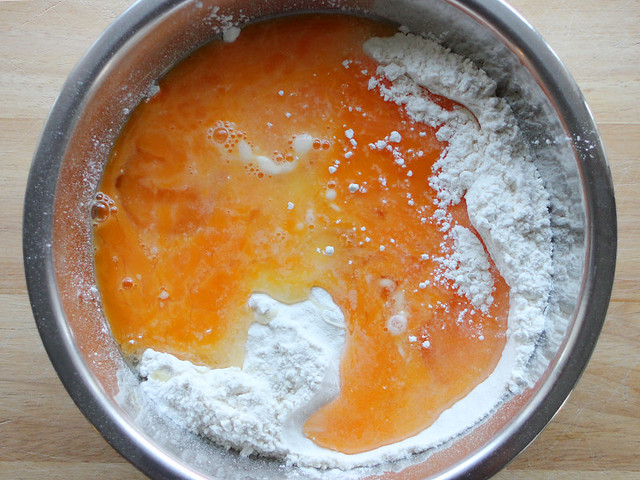 [/url]
[/url]
[url=http://www.flickr.com/photos/67856223@N06/7157475274/] [/url]
[/url]
[url=http://www.flickr.com/photos/67856223@N06/7157474698/] [/url]
[/url]
[url=http://www.flickr.com/photos/67856223@N06/7157474200/]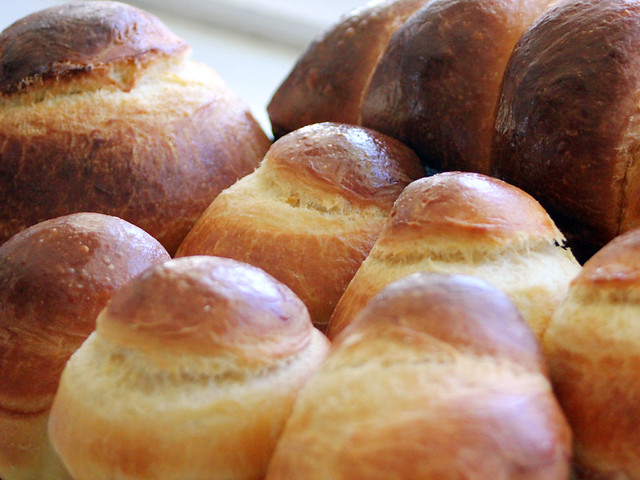 [/url]
[/url]
[url=http://www.flickr.com/photos/67856223@N06/7157472254/]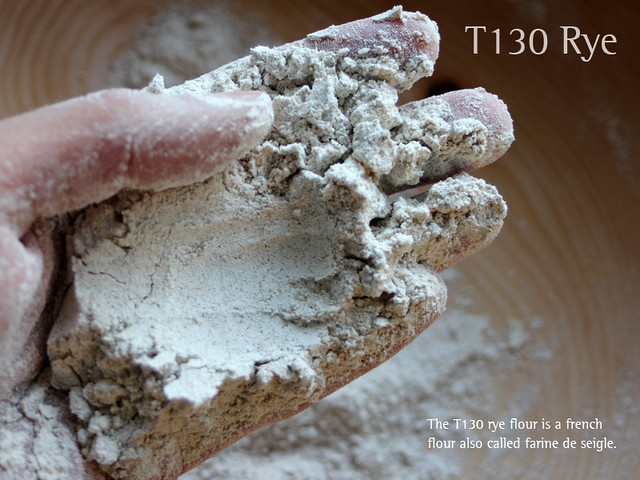 [/url]
[/url]
T130 Rye
For my experiments with this medium rye flour I took inspiration from photos of the amazing crusts of the tourte de seigle found in the boulangerie windows of Paris. It’s the contrast I love─the dark well baked crust scattered with flour coated islands.
[url=http://www.flickr.com/photos/67856223@N06/7157471532/] [/url]
[/url]
Tourte de Seigle adapted from Denis Fatet’s formula at www.cannelle.com
Formula
Overview | Weight | % |
Total dough weight | 1200g |
|
Total flour | 678g | 100% |
Total water | 522g | 77% |
Total salt | 13g | 2% |
Prefermented flour | 319g | 47% |
|
|
|
Sourdough build: 1h 30 @ 35°C |
|
|
Levain at 60% hydration | 240g | 141% |
T130 rye flour | 170g | 100% |
Water at 70°C | 170g | 100% |
Salt | 5g | 3% |
|
|
|
Final Dough: 1h 45 @ 40°C |
|
|
Rye flour T130 sifted or T85 rye | 358g | 100% |
Water at 70°C | 262g | 73% |
Salt | 8g | 2% |
Sourdough | 580g | 162% |
Method
- Prepare sourdough: Stir hot water into rye flour then add levain and mix until smooth. Sprinkle with rye flour and allow to rise for 1hr 30 at 35°C. Cracks will appear on the surface of the sourdough.
- Prepare final dough: Stir hot water into rye flour and salt then mix in sourdough until smooth. With wet hands round the dough and flatten into a round disc. Set to proof seam side down on floured parchment paper. Dust with flour and smooth with hand to ensure an even coating. Proof uncovered and away from draughts.
- Proof for 1h 45 at 40°C. Cracks will appear on surface during proofing.
- Load into oven with steam at 270°C for 10 mins then reduce temperature to 250°C and bake a further 60 mins.
I have to be honest, I was a little nervous about the idea of mixing the levain into the hot water and flour mix. But my worries were unfounded. The hot mix cooled as I stirred it and cooled even further when I added the levain creating a warm sourdough sponge that really went off fast.
I have heard that keeping a correct proofing temperature greatly assists with even cracking over the surface so the tourte de seigle proofed in our tiny bathroom under the heat lamp. I pushed the proofing to two hours but think next time I will reduce it to the specified time as the crumb shows some signs of slight over-proofing.
This is a crust lovers bread. The crumb is smooth and mild with only a hint of sourness. After many bakes of whole-grain ryes this bread is a pleasant change─A perfect balance of flavour and texture. But most importantly I love the way it looks. Dramatic bread! Breakfast during the week has been slices of this slathered with cultured butter.
[url=http://www.flickr.com/photos/67856223@N06/7157470874/] [/url]
[/url]
[url=http://www.flickr.com/photos/67856223@N06/7157470180/] [/url]
[/url]
[url=http://www.flickr.com/photos/67856223@N06/7157469240/] [/url]
[/url]
T65
The classic French bread for a classic French flour. Looking again to ‘The taste of Bread’ I used Raymond Calvel’s Pain au Levain formula substituting the T55 flour with the T65 I had on hand. At 64% the hydration was quite a bit lower than what I have been mixing recently but after an autolyse and solid 15 min mix by hand it produced a smooth and silky dough. It certainly felt different to the Australian flours I have been using but I am not sure how to put it best into words. Softer to the touch perhaps?
While the book uses a spiral mix followed by a 50 min bulk fermentation I was mixing by hand so opted for a gentler mix followed by a longer three hour bulk ferment to build strength and maturity in the dough. The final proof stretched out through the afternoon as the temperatures dropped but all the time increased the flavour of this delicious bread.
[url=http://www.flickr.com/photos/67856223@N06/7157473226/] [/url]
[/url]
[url=http://www.flickr.com/photos/67856223@N06/7157468640/]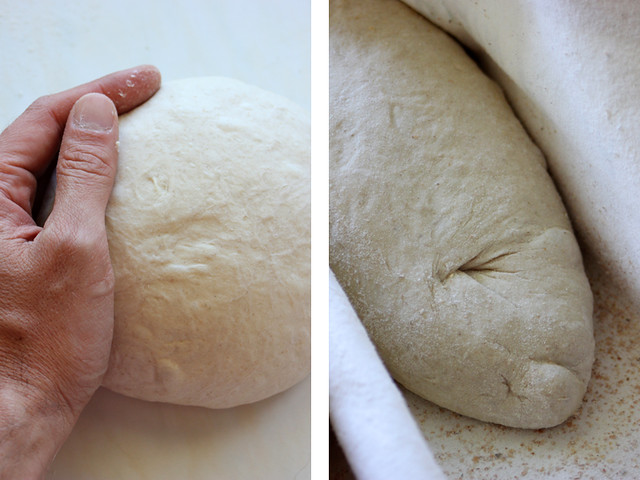 [/url]
[/url]
[url=http://www.flickr.com/photos/67856223@N06/7157467838/]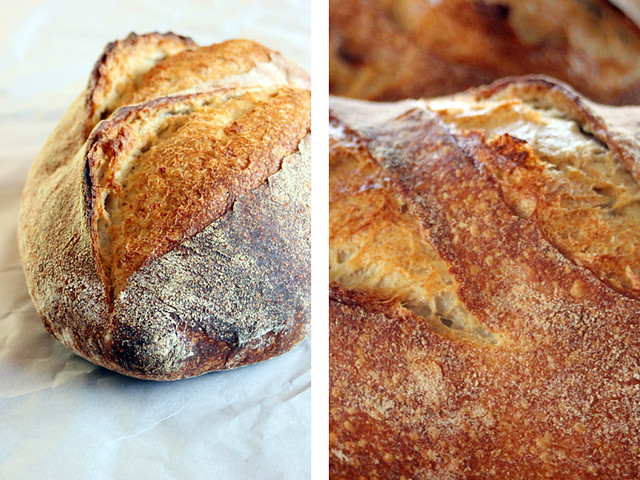 [/url]
[/url]
[url=http://www.flickr.com/photos/67856223@N06/7157466770/] [/url]
[/url]
[url=http://www.flickr.com/photos/67856223@N06/7157465976/] [/url]
[/url]
[url=http://www.flickr.com/photos/67856223@N06/7157465134/]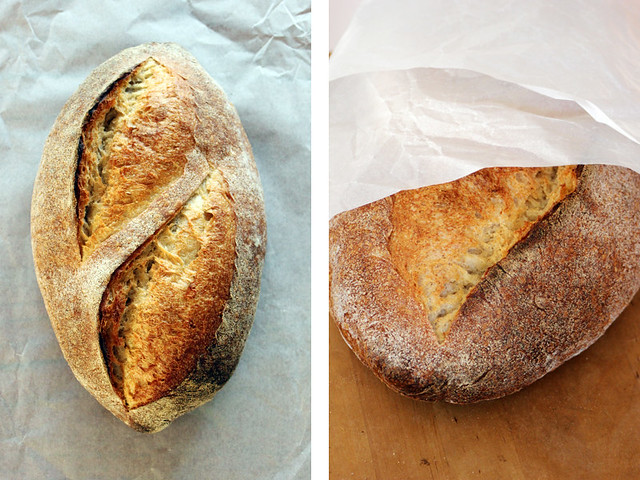 [/url]
[/url]
[url=http://www.flickr.com/photos/67856223@N06/7157464276/] [/url]
[/url]
Nat is torn. She loves the flavour and texture of this bread, more so than the some of the Australian organic flours I have been using … but it has come all the way from France … sigh. We are mindful of our footprint ...
I love the flavour as well so I am keen to keep experimenting with it … for the time being anyway.
Cheers,
Phil
- PiPs's Blog
- Log in or register to post comments
Congratulations on such successful baking! Vos pains sont magnifiques.
merci eliabel :)
My french is pretty much non-existent ... Nat has been to France and has a much better grasp of the language than this Aussie yobbo. She has a great laugh as I try and twist my way through their words.
Cheers,
Phil
Hi Phil,
I've always found your blog posts to be so well layed out and so easy on the eye! This is no exception!
Great work all round. Of course the brioche really caught my eye and the T65 loaf looks heavenly!
I like to try different flours too.
Really nice!
Michael
Thank you Michael,
Brioche is probably as far as I have taken my experiments with enriched breads. I 'love' my low hydration levain, but I don't think I can commit to the 4-5 hr feeding cycle that your starters are maintained with :) ... panettone will have to wait. I baked a seeded loaf this morning using the T65 flour for a friend who is french-she is quite excited about the flour. Increased the hydration to 67% and it felt just right.
We don't have a big choice of flours in Australia for the homebaker ... so this flour is a real treat for me.
Cheers,
Phil
Truly beautiful bread
Thank you ...
Cheers,
Phil
Hi Phil,
I'm always looking forward to your posts - the stunning photography, the wide range and good looks of the breads you bake are a constant source of inspiration. Your photography and breads are always astonishing.
Thank you for the kind words Hans,
Such a compliment coming from you ... your blog has been a fantastic source of inspiration and wisdom to me.
Cheers,
Phil
Phil, the brioche il gorgous, but the rye bread recipe is extremely interesting.
In the past I tried a couple of times a rye bread made entirely with scalded flour, using boiling water, but it didn't turn out as I wished. You method looks very promising and the loaf you produced is very invitating!
Thanks nico,
It would be interesting to try the same dough in a tin and see the result. This is intentionally a low profile bread and was proofed as thus. The hot water seems to make a difference to rye mix ... absorbed more water ... but saying that I haven't had a lot of experience using medium rye flour ... all the rye flour I have used in the past has been whole-grain.
Cheers,
Phil
Those are lovely breads, Phil. What fun to play with different flours, too.
Paul
Thanks Paul,
I agree about the flours ... it is fun to try your hand at something different from time-to-time.
Cheers,
Phil
Everything about your post!
What amazing breads, and so beautifully presented. As always, a great joy to read (and to imagine tastes and aromas).
Juergen
Thanks Juergen,
So glad you enjoyed it ... I was pretty happy with the results of the bread and photos ... the tourte de seigle is definitely my favourite though :)
Cheers,
Phil
had the unenviable taks of standing in front of a large group of American bakers (and team supporters) and being set up to tell us about how the judges decision process left Team USA in second place. He handled it with grace and generosity. Someone worth getting to know.
As someone thinks a lot about milling and flour and who lives in the great wheat producing region of the US - I often wonder why we don't have more variety in our flours. Yes, there are great craft millers in some costal regions - but as we think more and more about using local materials in our baking, I consider that there must be a way to produce a similar variety of flours. I also tend to think it is a matter of adapting methods and expectations to get the best from local flours.
But always fun to experiment with flours from other places.
Lovely as always.
Pat
Thanks Pat,
I came into contact with Brett via an wood-fired oven builder (who helped Alan Scott build Laurie's oven at Chalala) ... it really is a small world. Brett has been very generous and let me know about the Southern Cross Baking Group which I have since joined ... looking forward to participating in some of their activities.
I have the same thoughts about the flour available to home-bakers here ... commercially there is more variety but I am not too keen about a palette load of flour sitting in my kitchen :)
I agree about adapting methods ... and with the super strong organic flours from Southern Queensland I have had to do a lot of work to achieve results that I am happy with.
cheers,
Phil
Absolutely wonderful looking (and I"m sure tasting bake). Any time I see a blog of yours my eyes open up in order to be ready for the excitment and info they're about to look into. You blog is a breath of fresh air. Keep up the good work!
PS: that mini batard is a work of art!!
Ray
Thanks Ray,
Thanks so much for your generous comment ... I'll do my best :)
Cheers,
Phil
And your photography, as always, is spectacular.
I'd be interested in your judgement regarding the contributions of the flours versus the methods to differences in bread flavor in these bakes.
David
Thanks David,
The flavour contribution is yet to be totally confirmed ... this will take a few more bakes and consistency in procedures. Physically the dough looks different ... more creamy yellow colour than the plain flours I have been using. At the lower hydration I have had issues in the past with cardboard type textures using some australian flours ... hence my use and enjoyment of higher hydration doughs ... but this pain au levain at 64% hydration had a great mouthfeel and just the right amount of acetic flavours ... to be continued I guess ...
Cheers,
Phil
Very nice bakes, pictures and tales of 3 flours. Just fantastic.
Thanks dabrownman,
Was a lot of fun making them, photographing them .... and then eating them :)
cheers,
Phil
Thanks Tom,
My pick is the tourte de seigle ... Looks and tastes a treat ... but I am biased towards a dramatic rye :)
Cheers,
Phil
Thanks Marcus,
Can I ask what kind of mixer you bought? I think it would take a bit of adjusting after hand mixing for so many years ... but to save some time in the kitchen nowadays would be a blessing :) These bricohe doughs are gonna wear me out :)
Cheers
Phil
I settled on a little Bosch Compact. It’s just big enough to handle my usual batch of 2 kg or so of dough, didn’t break the bank and doesn’t take up much space. I liked the idea of a larger mixer but it occurred to me that this is as much bread as I can fit in my oven at one time anyway, so what would be the point? For now I’m still finishing most doughs by hand, using the mixer to get me through the early, messy stage of the mix. Even so, it definitely saves time. I’m sure with time and practice I will eventually feel comfortable letting it do more of the work – pizza night has already become “let’s see what happens to the dough if I mix it like this” night.
Marcus
Very nice Phil. What was the price of the imported flour as compared to your local flour? Have considered buying a mixer myself but my biggest consideration (apart from the price) would be where to put it in my tiny Asian kitchen.
Nice baking,
Syd
Thanks Syd,
The french flour is probably the cost of a cup of coffee more in expense for a 5kg bag. I can live with that :) We have the same issue with bench space here, but I think I would make it work.
Cheers,
Phil
Hey Phil,
Glad to see you going further and further into the dough.. I have the same feeling regarding flour from afar...I love using high extraction or T80-85 flour from Marino in Italy for pizza, but I can get a local flour from Upstate NY where it was once the breadbasket of America. Trumansburg flour mills wonderful flours, which I've talked about a bit on my blog, or I get the grain from the Co-op they buy the grain from. I followed your milling at home and do find a much nicer result, tired of supermarket flour. Now going on to different flavors, seaweed anpan, chili and cheddar bread with masa harina... Finally I just got some kefir grain, so I'll be culturing and sourdoughing like a Frankenstein!
Happy baking and thanks for your wonderful insight, photo's and lovely breads!
Jeremy
Thanks Jeremy,
You are certainly busy in that kitchen that of yours. Sounds like some amazing flavour combos you are investigating. I have had absolutely no experience with kefir grains so will be watching with interest.
Cheers,
Phil
Ahhhh, The Taste of Bread- takes a bit of focus and brain power to wade through! Your brioche texture looks absolutely perfect, and I love seeing the amazing crust on the rye- just the look of it is enough to inspire me to make it; the wheat loaf is perfection. Must go bake now! :)
I find I am still rereading sections so I can get it to sink in ... I then start analyzing how I bake bread and what steps or procedures I could change to fix a few things I am not happy with ... endless tinkering I tell you :)
thanks for the generous comment ... happy baking!
Cheers,
Phil
Phil,
As always, your breads look just delicious! The Tourte au Seigle recipe reminds me of the 100% rye bread that is traditional here in Finland (but the French version looks a lot lighter in colour).
Makes me want to try my hand at some rye bread too :)
Thanks Jarkko,
The medium rye flour has a much lighter colour than the home milled rye I have been baking with ... there is a pretty large chunk of white levain in there as well. I have a seen quite a few images of the rye breads in Finland ... they have the same look of the tourte de seigle that I just adore.
Cheers,
Phil
Hi Phil,
Well just a tad late... but no less appreciative of this post for so many reasons. Of course the photography, breads, and writeup are as always superb, but the information you've provided on Professor Calvel's book and your experience using the French flours I found particularly interesting. Calvel's ‘The Taste of Bread" is one I've had on my list shortly after joining TFL 2+ years ago. Even though it's just outside my price range for now, even for a used copy, I was encouraged to know you thought it a worthwhile addition to your collection.
Your brioche are lovely and tender looking Phil, well shaped and baked, well worth the effort of hand kneading this rich dough.
The Pain au Levain could be included in a bakery textbook as what one should look like through the various stages of the process. Very nicely done!
The Tourte de Seigle I found most interesting because of your description of the mixing and shaping, as well as the short ferment of the sour. Being accustomed to making and eating fairly sour rye breads, this formula sounds like an excellent alternative, hi-lighting the flavour of the grain rather than the sour. From your description of the process it sounds like one that needs to be watched over very closely. I don't see any signs of "slight over-proofing" in your photos at all, it looks spot on as far as I can tell.
Marking this as a favourite for future reference Phil. Thanks so much for posting this!
Best wishes,
Franko
Thanks Franko,
Good to hear from you :)
The book is not cheap is it ... but it has opened up my eyes and mind to so many of the little details that go into baking bread. As mentioned the section on flours was really interesting, but equally so was the chapters on fermentation and dough maturation. He values bakers yeast with white french flour as much as natural levain as long as the dough has been fermented and matured correctly. Each has it's place and role bread making. I found the section regarding nutritional value of bread a little hard to swallow though. He is not a fan of whole-grain breads at all, and there is a lot of details on the 'evil' of phytic acid and the unpleasantness of heavy whole-grain bread. Shame really, as phytic acid and it's reduction by a sourdough process is quite well known now.
Thanks for your kind words on the breads ... Yeah the Torte de Seigle had a really pleasant flavour ... no sourness at all. I get a little nervouse proofing breads like that ... I think a stuck my ear over it at the end and could slight popping sounds of bubble and jumped into action stations to get it in the oven.
So glad you enjoyed it Franko
Cheers,
Phil
Hi Phil,
I'm glad you are enjoying Mr. Calvel's book - it must be wonderful reading material.
It's so good to see the gorgeous breads you made with the French flours.
The crust on the rye is amazing, the pain au levain looks perfect, and such beautiful brioche (so impressed you mixed all that butter in by hand!).
:^) breadsong
Thanks for popping by Breadsong :)
Mr Calvel's book can be pretty heavy going at times ... I think if I had picked it up a few years ago I wouldn't have enjoyed it nearly as much.
I forgot to mention that I used Pat's (proth5) idea of 'remoullage' to coat the proving cloths.
It worked beatifully and gives the crust just a little bit of texture as well. So currently my basket/cloth dusting mixture consists of 1/3 AP flour, 1/3 Rice flour and 1/3 remoullage.
The brioche always seems like a good idea until I am halfway through the kneading ... then the discomfort starts and I then start drifting off in my head dreaming about a small spiral mixer sitting on my bench doing all the hard work for me ... They are so worth it though :)
Cheers,
Phil
Thanks Khalid,
Nice to read your kind comments :)
Brioche is well worth it ... and now that you have a mixer ... no excuses :) The quality of the butter and flour makes a big difference to the end result. I have used Richard's brioche formula quite a bit. Did you get the DVD with the book? The brioche shaping on the DVD is very handy to see. Mr Calvels brioche formula that I baked used a sponge and dough method which allowed me to autolyse the eggs, sugar and flour while the sponge was fermenting. This made the hand mixing a little easier and quicker. Richard's formula doesn't use an autolyse so it is quite messy to start with when mixing by hand - it cleans up nicely as you continue.
aah a mixer ... I wasted a day researching small spiral mixers ... I think my money would be better spent on a oven upgrade though. I can quite happily mix large quantities of dough by hand ... problem is that my oven is a bottleneck even in the smallest of bakes. An oven with a slightly bigger capacity would save me so much time in the kitchen.
All the best,
Phil
Hello Phil,
Great post as always, thank you for reflecting on Calvel's work like this. I remember having very similar thoughts to yours about his ideas on straight dough, and in particular his dismissal of high extraction flours.
I'm also most interested in your Rye bread. Having looked over and attempted Leader's Seigle d'Auvergne, I shyed away from the hot process he outlines in that formula. I always knew I would have to re-visit this; your post has helped to bring that visit closer, for sure.
I continue to enjoy reading about your baking adventures; a great journey, parallel to mine, across the other side of the world.
All good wishes
Andy
Thanks Andy,
Good to hear from you ... I can imagine you are keeping very busy at the moment ... well done on your market baking and sales.
I had the same trepidation regarding the hot water ... but decided to throw caution to the wind and dive in. It is quite a nice dough to work with and not too sticky. I think the T130 is much better behaved than my fresh milled rye and I have been thinking I may start sifting my milled rye ... it is still not to my liking.
Likewise I always enjoy your posts ... I think you are much further along in your journey with a focused direction than I am .... but the more I delve, the more I think I have found my direction.
Cheers,
Phil